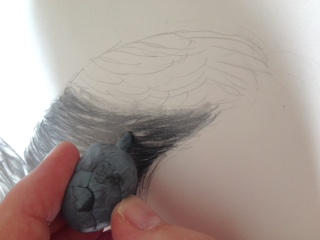Deviation Actions
Literature Text
Hello! I'm Jessica and I have an obsession with drawing especially hair. I feel like I should announce that like I'm in a support group. I am a traditional artist who prefers pencils to a paintbrush, but some of the principles (i.e. light sources) below can be applied across almost all mediums. This is not the only way to draw hair. It is just what works for me at the moment.
First things first! What am I working with?
Graphite pencils made by Faber Castell are my favorites. I do have other brands of pencils like Prismacolor, but what you really need is a wide range of lead grades. I currently use 6H-9B on a regular basis with 4H and 2B-6B being used most. With my 4H, I sketch rough drafts and shade the first layer of skin. My 2B-6B are used mostly for shading. The objective is to get a good range of values out of them. Without contrast, a drawing can look flat and unrealistic. 
Paper is equally important. There are many types, different brands, weights, etc. that all factor into how your finished product turns out. There are times where I'll use regular drawing paper because I want the texture of the paper to show through or I'll use Bristol when I want smooth shading. For portraits, I use Strathmore Bristol Smooth.
Erasers for highlights and texture are essential in my drawings. I have three types that I use. A Faber Castell dust free (big block eraser) for large areas, Faber Castell pencil eraser (a pencil that is filled with an eraser instead of graphite) that I use for smaller details, and a kneaded eraser for the smallest of details or whenever I need to pick up a very dark shade. I've been saying for months that I wish to try out a tombow zero eraser to add to my collection, but I haven't just yet. It is planned, so maybe my next tutorial will include it.
For blending, I use a combination of a blending stump (tortillion), paper towel, chamois, and my finger. Most of my blending is with a tortillion and paper towel.

The Drawing
When I usually draw hair, I go for what I consider the ribbon technique where individual strands are clumped together. Unfortunately, there are times when that doesn't work for me so I had to experiment with a combination of ribbon and individual hair drawing. I have already worked on this so we'll start with the unfinished section for examples.
In the first picture above, I had sketched the outline of the hair with my 4H then went over it with a 2B adding in lines going in the same direction as the reference. After I got a good outline, I added more wisps of hair in the same direction and blended with a tortillion. There are a few ways you can blend. Some people do tiny circles, others hatch as they would with their pencils. For hair, I do all of it. I'm really a whatever works kind of person. I usually hatch it roughly then do circles to get a nice smooth gradient of graphite. In the second picture above, you can see where I started to hatch.
Time lapse for the second part of hair
Finished
Feedback requested
Thanks!



















